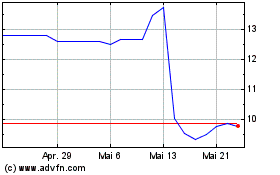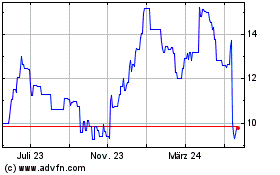Fennec Pharmaceuticals Inc. (NASDAQ: FENC; TSX: FRX), a commercial
stage specialty pharmaceutical company, today announced the U.S.
commercial launch and availability of PEDMARK® (sodium
thiosulfate injection) to reduce the risk of ototoxicity associated
with cisplatin in pediatric patients one month of age and older
with localized, non-metastatic solid tumors.
“We are proud to announce that PEDMARK is now
available to pediatric patients and their physicians who are in
need of options to help reduce the risk of cisplatin-induced
hearing loss,” said Rosty Raykov, chief executive officer of Fennec
Pharmaceuticals. “Children who get platinum-based chemotherapy,
such as cisplatin, are at risk for permanent hearing loss, a
condition that previously could only be managed with cochlear
implants and hearing aids. PEDMARK provides the first and only
FDA-approved treatment specifically designed to help protect
hearing in children and young adults after receiving cisplatin. We
look forward to engaging with healthcare providers and supporting
patient access to this breakthrough therapy with our assistance
program, Fennec HEARS™.”
The Company has established Fennec HEARS™, a
comprehensive single source program designed to connect PEDMARK
patients to both patient financial and product access support. The
program offers assistance and resources, regardless of insurance
type, that can address co-pays or lack of coverage when certain
eligibility requirements are met. Fennec HEARS also provides access
to care coordinators that can answer insurance questions about
coverage for PEDMARK and provide tips and resources for managing
treatment. For more information about product availability and
patient support, please contact the Fennec HEARS™ program at
1-833-7PEDMARK (1-833-773-3627).
PEDMARK was approved by the U.S. Food and Drug
Administration (FDA) in September 2022 based upon safety and
efficacy data from two pivotal open-label, randomized Phase 3
trials (Clinical Oncology Group [COG] Protocol ACCL0431 and SIOPEL
6), which compared PEDMARK plus cisplatin-based regimen to
cisplatin-based regimens alone for the reduction of
cisplatin-induced hearing loss in pediatric patients.
Advances in chemotherapy-based treatment
approaches for pediatric patients with localized, solid tumors have
improved, resulting in an 85 percent or higher five-year survival
rate for these patients.1 However, use of platinum-based
chemotherapy, still the treatment of choice in many cases, can be
toxic to the ears and cisplatin treatment frequently causes
permanent and irreversible bilateral (affecting both ears) hearing
loss. Permanent hearing loss can be seen in approximately 60
percent of children treated with cisplatin and can be as high as 90
percent.1,2 Until now, interventions with management strategies
such as cochlear implants and hearing aids only occurred after
hearing loss had been detected and these interventions do not
return normal hearing.3
The Marketing Authorization Application (MAA)
for sodium thiosulfate (tradename PEDMARQSI) is currently under
evaluation by the European Medicines Agency (EMA). Prior to its
approval in the U.S., the FDA granted PEDMARK Priority Review
designation in 2020 and Orphan Drug designation in 2004.
About Cisplatin-Induced
Ototoxicity Cisplatin and other platinum compounds are
essential chemotherapeutic agents for the treatment of many
pediatric malignancies. Unfortunately, platinum-based therapies can
cause ototoxicity, or hearing loss, which is permanent,
irreversible, and particularly harmful to the survivors of
pediatric cancer.4
The incidence of ototoxicity depends upon the
dose and duration of chemotherapy, and many of these children
require lifelong hearing aids or cochlear implants, which can be
helpful for some, but do not reverse the hearing loss and can be
costly over time.5 Infants and young children that are affected by
ototoxicity at critical stages of development lack speech and
language development and literacy, and older children and
adolescents often lack social-emotional development and educational
achievement.6
PEDMARK® (sodium thiosulfate
injection)PEDMARK® is the first and only U.S. Food and
Drug Administration (FDA) approved therapy indicated to reduce the
risk of ototoxicity associated with cisplatin treatment in
pediatric patients with localized, non-metastatic, solid tumors. It
is a unique formulation of sodium thiosulfate in single-dose,
ready-to-use vials for intravenous use in pediatric patients.7
PEDMARK is also the only therapeutic agent with proven efficacy and
safety data with an established dosing paradigm, across two
open-label, randomized Phase 3 clinical studies, the Clinical
Oncology Group (COG) Protocol ACCL0431 and SIOPEL 6.
In the U.S. and Europe, it is estimated that,
annually, more than 10,000 children may receive platinum-based
chemotherapy. The incidence of ototoxicity depends upon the dose
and duration of chemotherapy, and many of these children require
lifelong hearing aids. There is currently no established preventive
agent for this hearing loss and only expensive, technically
difficult, and sub-optimal cochlear (inner ear) implants have been
shown to provide some benefit. Infants and young children that
suffer ototoxicity at critical stages of development lack speech
language development and literacy, and older children and
adolescents lack social-emotional development and educational
achievement.
PEDMARK has been studied by co-operative groups
in two Phase 3 clinical studies of survival and reduction of
ototoxicity, COG ACCL0431 and SIOPEL 6. Both studies have been
completed. The COG ACCL0431 protocol enrolled childhood cancers
typically treated with intensive cisplatin therapy for localized
and disseminated disease, including newly diagnosed hepatoblastoma,
germ cell tumor, osteosarcoma, neuroblastoma, medulloblastoma, and
other solid tumors. SIOPEL 6 enrolled only hepatoblastoma patients
with localized tumors.
Indications and UsagePEDMARK®
(sodium thiosulfate injection) is indicated to reduce the risk of
ototoxicity associated with cisplatin in pediatric patients 1 month
of age and older with localized, non-metastatic solid tumors.
Limitations of UseThe safety
and efficacy of PEDMARK have not been established when administered
following cisplatin infusions longer than 6 hours. PEDMARK may not
reduce the risk of ototoxicity when administered following longer
cisplatin infusions, because irreversible ototoxicity may have
already occurred.
Important Safety
Information PEDMARK is contraindicated in
patients with history of a severe hypersensitivity to sodium
thiosulfate or any of its components.
Hypersensitivity reactions occurred in 8% to 13%
of patients in clinical trials. Monitor patients for
hypersensitivity reactions. Immediately discontinue PEDMARK and
institute appropriate care if a hypersensitivity reaction occurs.
Administer antihistamines or glucocorticoids (if appropriate)
before each subsequent administration of PEDMARK. PEDMARK may
contain sodium sulfite; patients with sulfite sensitivity may have
hypersensitivity reactions, including anaphylactic symptoms and
life-threatening or severe asthma episodes. Sulfite sensitivity is
seen more frequently in people with asthma.
PEDMARK is not indicated for use in pediatric
patients less than 1 month of age due to the increased risk of
hypernatremia or in pediatric patients with metastatic cancers.
Hypernatremia occurred in 12% to 26% of patients
in clinical trials, including a single Grade 3 case. Hypokalemia
occurred in 15% to 27% of patients in clinical trials, with Grade 3
or 4 occurring in 9% to 27% of patients. Monitor serum sodium and
potassium levels at baseline and as clinically indicated. Withhold
PEDMARK in patients with baseline serum sodium greater than 145
mmol/L.
Monitor for signs and symptoms of hypernatremia
and hypokalemia more closely if the glomerular filtration rate
(GFR) falls below 60 mL/min/1.73m2.
Administer antiemetics prior to each PEDMARK
administration. Provide additional antiemetics and supportive care
as appropriate.
The most common adverse reactions (≥25% with
difference between arms of >5% compared to cisplatin alone) in
SIOPEL 6 were vomiting, nausea, decreased hemoglobin, and
hypernatremia. The most common adverse reaction (≥25% with
difference between arms of >5% compared to cisplatin alone) in
COG ACCL0431 was hypokalemia.
Please see full Prescribing Information for
PEDMARK® at: www.PEDMARK.com.
About Fennec
PharmaceuticalsFennec Pharmaceuticals Inc. is a specialty
pharmaceutical company focused on the development and
commercialization of PEDMARK® to reduce the risk of
platinum-induced ototoxicity in pediatric patients. Further,
PEDMARK received FDA approval in September 2022 and has received
Orphan Drug Designation in the U.S. Fennec has a license agreement
with Oregon Health and Science University (OHSU) for exclusive
worldwide license rights to intellectual property directed to
sodium thiosulfate and its use for chemoprotection, including the
reduction of risk of ototoxicity induced by platinum chemotherapy,
in humans. For more information, please visit
www.fennecpharma.com.
Forward Looking
StatementsExcept for historical information described in
this press release, all other statements are forward-looking. Words
such as “believe,” “anticipate,” “plan,” “expect,” “estimate,”
“intend,” “may,” “will,” or the negative of those terms, and
similar expressions, are intended to identify forward-looking
statements. These forward-looking statements include statements
about our business strategy, timeline and other goals, plans and
prospects, including our commercialization plans respecting
PEDMARK®, the market opportunity for and market impact of PEDMARK®,
its potential impact on patients and anticipated benefits
associated with its use, and potential access to further funding
after the date of this release. Forward-looking statements are
subject to certain risks and uncertainties inherent in the
Company’s business that could cause actual results to vary,
including the risks and uncertainties that regulatory and guideline
developments may change, scientific data and/or manufacturing
capabilities may not be sufficient to meet regulatory standards or
receipt of required regulatory clearances or approvals, clinical
results may not be replicated in actual patient settings,
unforeseen global instability, including political instability, or
instability from an outbreak of pandemic or contagious disease,
such as the novel coronavirus (COVID-19), or surrounding the
duration and severity of an outbreak, protection offered by the
Company’s patents and patent applications may be challenged,
invalidated or circumvented by its competitors, the available
market for the Company’s products will not be as large as expected,
the Company’s products will not be able to penetrate one or more
targeted markets, revenues will not be sufficient to fund further
development and clinical studies, our ability to obtain necessary
capital when needed on acceptable terms or at all, the Company may
not meet its future capital requirements in different countries and
municipalities, and other risks detailed from time to time in the
Company’s filings with the Securities and Exchange Commission
including its Annual Report on Form 10-K for the year ended
December 31, 2021. Fennec disclaims any obligation to update these
forward-looking statements except as required by law.
For a more detailed discussion of related risk
factors, please refer to our public filings available
at www.sec.gov and www.sedar.com.
PEDMARK® and Fennec® are registered trademarks
of Fennec Pharmaceuticals Inc.
©2022 Fennec Pharmaceuticals Inc. All rights
reserved. FEN-1442-v3 10/22
For further information, please
contact:
Investors:Robert AndradeChief Financial
OfficerFennec Pharmaceuticals Inc.+1 919-246-5299
Corporate and Media:Lindsay Rocco Elixir Health
Public Relations+1 862-596-1304lrocco@elixirhealthpr.com
1 American Cancer Society. Key Statistics for Childhood Cancers.
Last Revised: January 12, 2022.
https://www.cancer.org/cancer/cancer-in-children/key-statistics.html.2
Langer T, Zehnhoff-Dinnesen A, Radtke S, et al. Understanding
Platinum-Induced Ototoxicity. Trends in Pharmacological Sciences.
August 2013, Vol. 34, No. 8:458-469.3 Paken J, Govender C. Pillay
M, et al. Cisplatin-Associated Ototoxicity: A Review for The Health
Professional. Journal of Toxicology. Vol. 2016:1-13.4 Rybak L.
Mechanisms of Cisplatin Ototoxicity and Progress in Otoprotection.
Current Opinion in Otolaryngology & Head and Neck Surgery.
2007, Vol. 15: 364-369.5 Landier W. Ototoxicity and Cancer Therapy.
Cancer. June 2016 Vol. 122, No.11: 1647-1658.6 Bass JK, Knight KR,
Yock TI, et al. Evaluation and Management of Hearing Loss in
Survivors of Childhood and Adolescent Cancers: A Report from the
Children's Oncology Group. Pediatric Blood & Cancer. 2016
Jul;63(7):1152-1162.7 PEDMARK® Prescribing Information. 11
Description.
Fennec Pharmaceuticals (TSX:FRX)
Historical Stock Chart
Von Dez 2024 bis Jan 2025

Fennec Pharmaceuticals (TSX:FRX)
Historical Stock Chart
Von Jan 2024 bis Jan 2025
